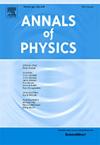Path integrals from spacetime quantum actions
IF 3
3区 物理与天体物理
Q2 PHYSICS, MULTIDISCIPLINARY
引用次数: 0
Abstract
The possibility of extending the canonical formulation of quantum mechanics (QM) to a space–time symmetric form has recently attracted wide interest. In this context, a recent proposal has shown that a spacetime symmetric many-body extension of the Page and Wootters mechanism naturally leads to the so-called Quantum Action (QA) operator, a quantum version of the action of classical mechanics. In this work, we focus on connecting the QA with the well-established Feynman’s Path Integral (PI). In particular, we present a novel formalism which allows one to identify the “sum over histories” with a quantum trace, where the role of the classical action is replaced by the corresponding QA. The trace is defined in the extended Hilbert space resulting from assigning a conventional Hilbert space to each time slice and then taking their tensor product. The formalism opens the way to the application of quantum computation protocols to the evaluation of PIs and general correlation functions, and reveals that different representations of the PI arise from distinct choices of basis in the evaluation of the same trace expression. The Hilbert space embedding of the PIs also discloses a new approach to their continuum time limit. Finally, we discuss how the ensuing canonical-like version of QM inherits many properties from the PI formulation, thus allowing an explicitly covariant treatment of spacetime symmetries.
时空量子作用的路径积分
将量子力学经典公式扩展到时空对称形式的可能性最近引起了广泛的兴趣。在这种背景下,最近的一项提议表明,Page和wooters机制的时空对称多体扩展自然会导致所谓的量子作用算子(QA),这是经典力学作用的量子版本。在这项工作中,我们专注于将QA与完善的费曼路径积分(PI)联系起来。特别是,我们提出了一种新的形式,它允许人们用量子轨迹识别“历史总和”,其中经典动作的角色被相应的QA取代。轨迹是在扩展希尔伯特空间中定义的,这是通过给每个时间片分配一个传统的希尔伯特空间,然后取它们的张量积而得到的。该形式化理论为将量子计算协议应用于PI和一般相关函数的评估开辟了道路,并揭示了PI的不同表示源于对同一迹表达式的评估中不同的基选择。同时,利用希尔伯特空间嵌入的方法也揭示了一种求解连续时间限制的新方法。最后,我们讨论了QM的规范化版本如何继承PI公式的许多性质,从而允许对时空对称性进行显式协变处理。
本文章由计算机程序翻译,如有差异,请以英文原文为准。
求助全文
约1分钟内获得全文
求助全文
来源期刊

Annals of Physics
物理-物理:综合
CiteScore
5.30
自引率
3.30%
发文量
211
审稿时长
47 days
期刊介绍:
Annals of Physics presents original work in all areas of basic theoretic physics research. Ideas are developed and fully explored, and thorough treatment is given to first principles and ultimate applications. Annals of Physics emphasizes clarity and intelligibility in the articles it publishes, thus making them as accessible as possible. Readers familiar with recent developments in the field are provided with sufficient detail and background to follow the arguments and understand their significance.
The Editors of the journal cover all fields of theoretical physics. Articles published in the journal are typically longer than 20 pages.
 求助内容:
求助内容: 应助结果提醒方式:
应助结果提醒方式:


